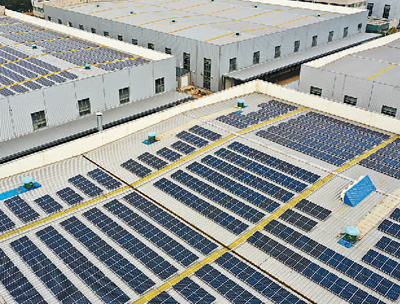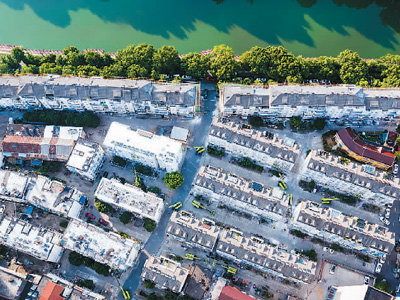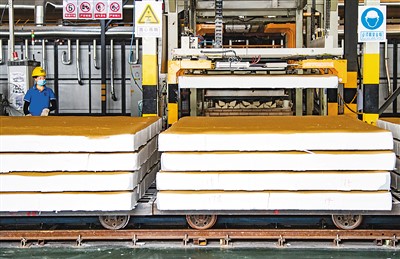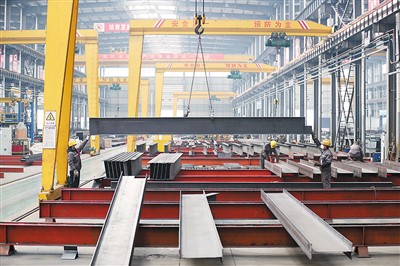China strives to advance green transformation of construction sector
By promoting the green renovation of existing buildings, the use of green building materials, and the development of prefabricated construction, China has achieved energy conservation in new buildings across the board in recent years.

Photo shows photovoltaic panels on roofs of an industrial park in Changzhou city, east China’s Jiangsu Province. (Photo/Hu Ping)
By the end of the first half of 2022, the floorage of China’s green buildings accounted for over 90 percent of all new buildings, according to the latest data from the country’s Ministry of Housing and Urban-Rural Development (MOHURD).
Thanks to the adoption of advanced technologies, China’s green building industry have grown by leaps and bounds and become a new“calling card” for low-carbon and environmentally friendly development while changing people’s lives.
Statistics revealed that the whole building industry accounted for more than 50 percent of the total amount of carbon dioxide emissions in China.
As the country aims to peak carbon dioxide emissions by 2030 and achieve carbon neutrality by 2060, it has been accelerating the development of green buildings.

Photo taken on July 15, 2022 shows the site of renovating an old urban residential community in Fanchang district, Wuhu city, east China’s Anhui Province. (Photo/Xiao Benxiang)
Green buildings refer to high-quality buildings that feature low energy consumption and provide comfortable and environmentally friendly working or living spaces throughout their life cycles.
To ensure that green buildings can better reduce carbon dioxide emissions, the first step is to cut energy consumption throughout green buildings’ life cycles, said Zhu Yingxin, a professor at the School of Architecture, Tsinghua University.
“For example, climate conditions such as natural ventilation and natural lighting can be used according to local conditions to reduce energy demand for heating, cooling and lighting,” Zhu added.
The exhibition center of the National Cybersecurity Center for Education and Innovation in Wuhan, capital city of central China’s Hubei Province, features a wide-span layout of column-free design and an all-glass curtain wall structure, which can reduce energy consumption for lighting.
In addition, CITIC General Institute of Architectural Design and Research Co., Ltd., the designer of the exhibition center, developed patented technologies such as an automatic control system for ventilation and heat dissipation to address problems including rapid increases in indoor temperatures, according to Tang Xiaoliang, an executive of the company.
The system can automatically open and shut 32 electronic skylights installed on the central area of the daylighting roof according to the temperature and heat radiation intensity on the roof, thus effectively controlling the roof temperature. Thanks to the system, the room temperature difference can vary up to 10 degrees Celsius, Tang explained.

Visitors view exhibits at China Building Science Conference and Green Intelligent Building Expo in the national convention and exhibition center in north China’s Tianjin Municipality, June 24, 2021. (Xinhua/Sun Fanyue)
The exhibition center is also equipped with ground-source heat pumps. These pumps transfer waste heat in the building out during the summer to secure a room temperature of 26 degrees Celsius and transfer heat stored in the earth into the building during the winter, said Chen Yanhua, chief engineer of the company, adding that these pumps help directly reduce carbon dioxide emissions by more than 35 percent.
The exhibition center epitomizes China’s efforts to advance the green transformation of the construction sector.
China aims to greatly improve its capabilities in energy conservation of buildings and the recycling of construction wastes by 2030, with energy efficiency reaching advanced international levels, according to an action plan on the work to peak carbon dioxide emissions in the construction sector recently unveiled by the MOHURD and the National Development and Reform Commission.
Meanwhile, the application of prefabricated construction techniques has made factory-built houses and the green transformation during construction a possibility. The prefabricated units, which go through a standardized production process, will be transported to a construction site, where constructors will build houses just like building blocks.

A worker produces a new type of eco-friendly building materials at a company in Xinyu city, east China’s Jiangxi Province, June 22. (Photo/Zhao Chunliang)
Recently, China’s first fully prefabricated high-piled wharf – a berth of the liquid bulk cargo terminal project located at Xuwei port area in Lianyungang city, east China’s Jiangsu Province, was accepted. The wharf is designed by CCCC Third Harbor Consultants Co., Ltd.
“Thanks to the wide application of prefabricated construction techniques, only 195 prefabricated units were used for the berth. Compared with the traditional construction method of building a high-piled wharf, the total number of prefabricated units was reduced by over 80 percent,” said Guo Zhaojia, chief designer of the project.
Guo added that the application of prefabrication saved 20 percent of concrete consumption and reduced carbon emissions at the construction site by 75 percent.
The application of prefabricated construction techniques can reduce pollution, save resources and reduce costs while improving production efficiency, said Hu Jiaxi, a senior architect of the China Academy of Building Research.
Last year, China issued a guideline underpinning green development in urban and rural areas, calling for greater efforts to develop prefabricated buildings. Next, the MOHURD will promote the market-oriented development of prefabricated buildings on a large scale.

Workers at a green building company in Yuncheng city, north China’s Shanxi Province produce steel structures for the third construction phase of the Xianyang International Airport in northwest China’s Shaanxi Province. (Photo/Yan Xin)
Changing the old construction model featuring large-scale construction and massive consumption and emission is also an important measure to peak carbon dioxide emissions in the construction sector. China has accelerated the green renovation of existing buildings in this regard.
The MOHURD will further increase the proportion of green buildings, promote the green renovation of existing buildings to improve energy efficiency and lower carbon emissions, and reduce energy consumption during the operation of buildings.
 京公网安备 11010802027341号
京公网安备 11010802027341号